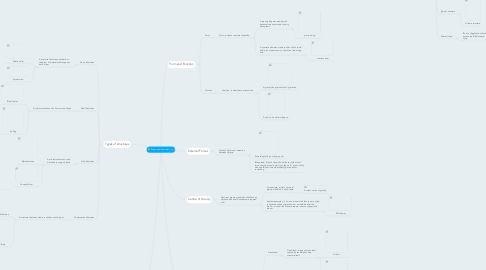
1. Types of structures
1.1. Frame Structures
1.1.1. A structure that uses a network, or skeleton, of materials that supports each other.
1.1.1.1. Goalie's Net
1.1.1.2. Spider web
1.2. Shell Structures
1.2.1. A structure that has a hollow, curved. shape
1.2.1.1. Bike Helmet
1.2.1.2. An Egg
1.3. Solid Structures
1.3.1. A structure that uses solid materials to support loads.
1.3.1.1. Marble statue
1.3.1.2. Concrete Dam
1.4. Combination Structures
1.4.1. A structure that has a frame, a shell and solid parts.
1.4.1.1. Human Skeleton
1.4.1.2. A Building
2. Internal Forces
2.1. Internal Force: a force between two parts of a body.
2.1.1. Torsion: twisting forces created in an object as a result of a twisting motion being applied to the object
2.1.1.1. Twisting of a ballerina while she is dancing
2.1.1.1.1. Ballerina twisting
2.1.1.2. When you are attempting to put on your jacket in the morning
2.1.1.2.1. Someone attempting to put on a jacket
2.1.2. Tension: an internal force pulling on particles of an object apart
2.1.2.1. When you are trying to fight over a friend, you tend to pull their arms/legs
2.1.2.1.1. Siblings fighting over a doll
2.1.2.2. When you are trying to open a snack, some wrappers tend to make you pull to open.
2.1.3. Shear: forces acting in a object as a result of pulling in the opposite direction
2.1.3.1. When you snap a twig from both sides
2.1.4. Compression: a force that presses of squeezes an object together
2.1.4.1. When you are done with your wrapper, you usually would crumple the wrapper as if you were squishing it.
2.1.4.2. When you are squeezing a lemon, you would squeeze the lemon to get the juice.
3. The Eiffel Tower
3.1. Purpose, form and function
3.1.1. The function is to get tourists.
3.1.2. The form is a frame structure.
3.1.3. The purpose of the Eiffel tower is to mark the 100 year anniverisaty of the French revolution.
3.2. Loads
3.2.1. The Eiffel Tower is able to carry weight because it is a frame structure and frame structures are very strong. Also all the frames work together to carry the weight.
3.3. Type of structure
3.3.1. A frame structure.
3.4. External force.
3.4.1. (Point of Application) If some helicopter comes pushes the Eiffel tower at the top, the top would snap.
3.4.1.1. Eiffel tower snapping in half
4. Form and Function
4.1. Form
4.1.1. Form: is what a structure looks like.
4.1.1.1. A grocery bag was made small because it was not made to carry heavy items.
4.1.1.1.1. grocery bag
4.1.1.2. A concrete dam was made solid so that it could hold a lot of water and so that it can last a long time.
4.1.1.2.1. concrete dam
4.2. Function
4.2.1. Function: is what the structure does.
4.2.1.1. A grocery bag carries food/ groceries.
4.2.1.2. A chair is made for sitting on.
5. External Forces
5.1. Gravity:The force of attraction between objects.
5.1.1. Something falling on the ground
5.1.2. (Magnitude) If I push the with a bulldozer with a lot of force, the tower would start to collapse. If I push it softly with a bulldozer, it would probably put a dent or something.
6. Centre of Gravity
6.1. Centre of gravity means the middle of an objedt which would not become toppled over
6.1.1. For example, a ruler's centre of gravity, would be in the middle.
6.1.1.1. A ruler's centre of gravity.
6.1.2. Another example is if it was a broom stick that you are trying to figre the centre of gravity from, it would be near the broom. it is near the broom because it has to support the broom.
6.1.2.1. Eiffel tower
7. Loads
7.1. Load: the forces that act on a structure.
7.1.1. Static Load
7.1.1.1. Dead load
7.1.1.1.1. Dead load: A type of static load caused by the weight of the structure itself.
7.1.1.2. Live load
7.1.1.2.1. Live load: A type of static load caused by the sight of the objects it supports.
7.1.1.3. Dynamic Load
7.1.1.3.1. Dynamic load: How much force you put on a structure.

